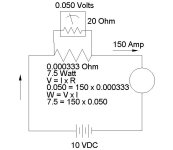HI EXPERTS
I have a panel meter which indicates DC current from 0 to 150 amperes.
The meter has resistance of 20 ohms and requires 0 to 50 mili volt . I need to calculate the value of shunt resistor .
My DC source voltage which is connected to meter is 10 v at max
Thanks experts
I have a panel meter which indicates DC current from 0 to 150 amperes.
The meter has resistance of 20 ohms and requires 0 to 50 mili volt . I need to calculate the value of shunt resistor .
My DC source voltage which is connected to meter is 10 v at max
Thanks experts






